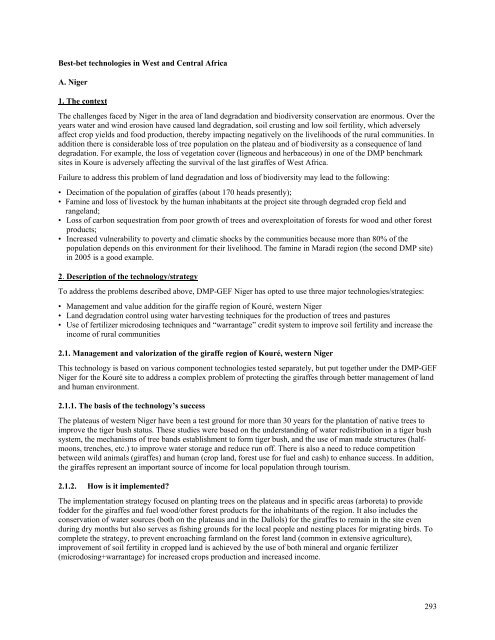ICRISAT Archival Report 2006 - The seedlings of success in the ...
ICRISAT Archival Report 2006 - The seedlings of success in the ...
ICRISAT Archival Report 2006 - The seedlings of success in the ...
Create successful ePaper yourself
Turn your PDF publications into a flip-book with our unique Google optimized e-Paper software.
Best-bet technologies <strong>in</strong> West and Central Africa<br />
A. Niger<br />
1. <strong>The</strong> context<br />
<strong>The</strong> challenges faced by Niger <strong>in</strong> <strong>the</strong> area <strong>of</strong> land degradation and biodiversity conservation are enormous. Over <strong>the</strong><br />
years water and w<strong>in</strong>d erosion have caused land degradation, soil crust<strong>in</strong>g and low soil fertility, which adversely<br />
affect crop yields and food production, <strong>the</strong>reby impact<strong>in</strong>g negatively on <strong>the</strong> livelihoods <strong>of</strong> <strong>the</strong> rural communities. In<br />
addition <strong>the</strong>re is considerable loss <strong>of</strong> tree population on <strong>the</strong> plateau and <strong>of</strong> biodiversity as a consequence <strong>of</strong> land<br />
degradation. For example, <strong>the</strong> loss <strong>of</strong> vegetation cover (ligneous and herbaceous) <strong>in</strong> one <strong>of</strong> <strong>the</strong> DMP benchmark<br />
sites <strong>in</strong> Koure is adversely affect<strong>in</strong>g <strong>the</strong> survival <strong>of</strong> <strong>the</strong> last giraffes <strong>of</strong> West Africa.<br />
Failure to address this problem <strong>of</strong> land degradation and loss <strong>of</strong> biodiversity may lead to <strong>the</strong> follow<strong>in</strong>g:<br />
• Decimation <strong>of</strong> <strong>the</strong> population <strong>of</strong> giraffes (about 170 heads presently);<br />
• Fam<strong>in</strong>e and loss <strong>of</strong> livestock by <strong>the</strong> human <strong>in</strong>habitants at <strong>the</strong> project site through degraded crop field and<br />
rangeland;<br />
• Loss <strong>of</strong> carbon sequestration from poor growth <strong>of</strong> trees and overexploitation <strong>of</strong> forests for wood and o<strong>the</strong>r forest<br />
products;<br />
• Increased vulnerability to poverty and climatic shocks by <strong>the</strong> communities because more than 80% <strong>of</strong> <strong>the</strong><br />
population depends on this environment for <strong>the</strong>ir livelihood. <strong>The</strong> fam<strong>in</strong>e <strong>in</strong> Maradi region (<strong>the</strong> second DMP site)<br />
<strong>in</strong> 2005 is a good example.<br />
2. Description <strong>of</strong> <strong>the</strong> technology/strategy<br />
To address <strong>the</strong> problems described above, DMP-GEF Niger has opted to use three major technologies/strategies:<br />
• Management and value addition for <strong>the</strong> giraffe region <strong>of</strong> Kouré, western Niger<br />
• Land degradation control us<strong>in</strong>g water harvest<strong>in</strong>g techniques for <strong>the</strong> production <strong>of</strong> trees and pastures<br />
• Use <strong>of</strong> fertilizer microdos<strong>in</strong>g techniques and “warrantage” credit system to improve soil fertility and <strong>in</strong>crease <strong>the</strong><br />
<strong>in</strong>come <strong>of</strong> rural communities<br />
2.1. Management and valorization <strong>of</strong> <strong>the</strong> giraffe region <strong>of</strong> Kouré, western Niger<br />
This technology is based on various component technologies tested separately, but put toge<strong>the</strong>r under <strong>the</strong> DMP-GEF<br />
Niger for <strong>the</strong> Kouré site to address a complex problem <strong>of</strong> protect<strong>in</strong>g <strong>the</strong> giraffes through better management <strong>of</strong> land<br />
and human environment.<br />
2.1.1. <strong>The</strong> basis <strong>of</strong> <strong>the</strong> technology’s <strong>success</strong><br />
<strong>The</strong> plateaus <strong>of</strong> western Niger have been a test ground for more than 30 years for <strong>the</strong> plantation <strong>of</strong> native trees to<br />
improve <strong>the</strong> tiger bush status. <strong>The</strong>se studies were based on <strong>the</strong> understand<strong>in</strong>g <strong>of</strong> water redistribution <strong>in</strong> a tiger bush<br />
system, <strong>the</strong> mechanisms <strong>of</strong> tree bands establishment to form tiger bush, and <strong>the</strong> use <strong>of</strong> man made structures (halfmoons,<br />
trenches, etc.) to improve water storage and reduce run <strong>of</strong>f. <strong>The</strong>re is also a need to reduce competition<br />
between wild animals (giraffes) and human (crop land, forest use for fuel and cash) to enhance <strong>success</strong>. In addition,<br />
<strong>the</strong> giraffes represent an important source <strong>of</strong> <strong>in</strong>come for local population through tourism.<br />
2.1.2. How is it implemented?<br />
<strong>The</strong> implementation strategy focused on plant<strong>in</strong>g trees on <strong>the</strong> plateaus and <strong>in</strong> specific areas (arboreta) to provide<br />
fodder for <strong>the</strong> giraffes and fuel wood/o<strong>the</strong>r forest products for <strong>the</strong> <strong>in</strong>habitants <strong>of</strong> <strong>the</strong> region. It also <strong>in</strong>cludes <strong>the</strong><br />
conservation <strong>of</strong> water sources (both on <strong>the</strong> plateaus and <strong>in</strong> <strong>the</strong> Dallols) for <strong>the</strong> giraffes to rema<strong>in</strong> <strong>in</strong> <strong>the</strong> site even<br />
dur<strong>in</strong>g dry months but also serves as fish<strong>in</strong>g grounds for <strong>the</strong> local people and nest<strong>in</strong>g places for migrat<strong>in</strong>g birds. To<br />
complete <strong>the</strong> strategy, to prevent encroach<strong>in</strong>g farmland on <strong>the</strong> forest land (common <strong>in</strong> extensive agriculture),<br />
improvement <strong>of</strong> soil fertility <strong>in</strong> cropped land is achieved by <strong>the</strong> use <strong>of</strong> both m<strong>in</strong>eral and organic fertilizer<br />
(microdos<strong>in</strong>g+warrantage) for <strong>in</strong>creased crops production and <strong>in</strong>creased <strong>in</strong>come.<br />
293

















